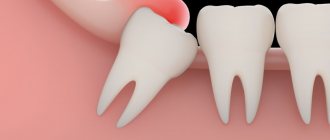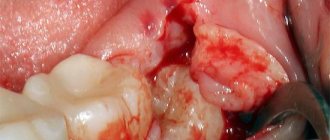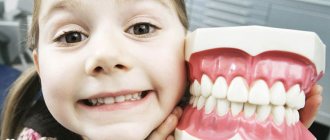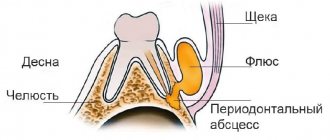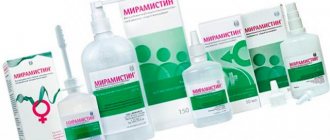Why do ulcers appear on the gums, and is it always dangerous?
There are many possible reasons. To understand how dangerous the appearance of certain lesions on the gums is, you need to look at additional accompanying symptoms:
- in case it is trivial mechanical damage. The gums can be damaged by hard food, a toothbrush, or a foreign object. These lesions may resolve in 3-5 days. If a person does not brush his teeth, then infection is added to these damages, and healing may take several weeks.
- Sometimes ulcers can appear as a result of wearing orthodontic structures, braces or removable dentures.
Gum diseases
There are 3 gum diseases that can cause pain. These include:
- Gingivitis.
- Periodontal disease.
- Periodontitis.
The main cause of gum inflammation is poor hygiene and the formation of stone and plaque, which activates the proliferation of pathogenic microflora. Inflamed gums begin to swell, turn blue or red. In advanced cases, tooth mobility appears, which can later cause tooth loss.
Gingivitis
Gums with gingivitis
Gingivitis is an inflammation of the gums, which most often causes pain between the teeth. It is superficial in nature, and at an early stage a person experiences the following symptoms:
- Redness and swelling.
- Bleeding.
- Itching.
- Unpleasant smell.
- The pain intensifies after eating.
As it progresses, small ulcers may form on the gums, which are particularly painful. Subsequently, the gum tissue decreases, which leads to exposure of the tooth root. There is severe discomfort while eating.
- Pocket in the gum between the teeth - how to treat
Important! The main cause of gingivitis is the formation of plaque due to poor hygiene.
Treatment is carried out by a dentist and depends on the severity of the gingivitis. Initially, plaque removal is required, and hygiene products are selected individually. In severe cases, overgrown gum tissue is removed.
Types of gingivitis
The standard treatment regimen includes the use of:
- Anti-inflammatory gels (Cholisal, Mundizal-gel, Kamistad).
- Paste (Lacalut fitoformula, Parodontax F, PresiDENT exclusive).
- Rinse aids (Lacalut “aktiv”, Paradontax, President profi).
- Vitamins (B1, C, A, E).
Treatment lasts 10 days. Treatment of gums with gels is carried out 2 times a day. Rinse aids are used after meals. During treatment, it is necessary to use a soft brush to avoid further trauma to the gums.
Periodontitis
Inflammatory gum disease, which is characterized by damage to periodontal tissue. It is a consequence of untreated gingivitis.
Gums with periodontitis
The symptoms are similar to gingivitis, but other unpleasant signs appear:
- Severe swelling and suppuration.
- Pain when touched.
- Gaps between teeth and their loosening.
Periodontitis can be caused by failure to comply with hygiene rules, deficiency of vitamins and beneficial microelements, and improper bite and tooth shape. The treatment regimen coincides with therapy during gingivitis. After removing plaque and stone, a person needs to carefully maintain hygiene for 2 weeks.
Stages of periodontitis
Important! Advanced stages of periodontitis require cutting the tissues surrounding the tooth and removing deep stone.
Local treatment includes the use of anti-inflammatory gels (Acepta, Cholisal, Mundizal-gel). If tooth mobility occurs, the installation of temporary splints is required, which can be replaced with a prosthesis if necessary.
Periodontal disease
Damage to periodontal tissue. Pain occurs not only between the teeth, but also around them. The disease occurs rarely - no more than 8% of dental patients. Leads to increased tooth mobility and does not relate to inflammatory pathologies. Symptoms:
- Bleeding.
- Exposing the neck of the teeth.
- Severe pain.
- Tissue atrophy.
Periodontal diseases
The main reason is poor circulation in the periodontal tissues. Periodontal disease is often a consequence of systemic diseases of the body (diabetes, atherosclerosis, hypertension). It can occur in people with a hereditary predisposition.
- Caries between teeth - why I have it and my neighbor doesn’t
The treatment is long-term, and at the first stage includes the removal of tartar. Severe stages require the use of gels, ointments and rinses with an anti-inflammatory effect. If there are carious teeth, they are treated.
Local treatment includes:
- Rinse with 0.05% Chlorhexidine solution.
- Applications "Cholisal gel".
Dental gel Cholisal
The average duration of treatment is 10 days. Rinsing with Chlorhexidine solution should be done in the morning (after breakfast) and in the evening. Then the teeth and gums are dried with a cotton swab and the gel is carefully applied to the marginal part of the gum. After using medications, it is not recommended to eat for 2 hours.
The most common diseases of the oral cavity in which ulcers appear
- ulcerative necrotizing gingivitis. The cause of this disease is bacteria that multiply when immunity decreases. Extensive ulcers appear on the gums, regional lymph nodes become enlarged, and the temperature may rise
- chronic recurrent aphthous stomatitis. Up to 4-5 white spots first appear in the mouth, which later turn into ulcers. There is no temperature or other problems related to well-being. If such symptoms appear 1-2 times a year in small quantities, then there should be no cause for concern. Frequent occurrence is associated with weakened immunity and possible intestinal diseases, as well as allergies.
- acute herpetic stomatitis. Herpetic stomatitis occurs in a child when he first encounters the herpes virus. Many bubbles appear on the gums, which, after bursting, turn into ulcers that merge with each other. The gums are always bright red, and the ulcers themselves are very painful, the temperature may rise
Treatment of teeth and gums
A dentist can determine why the gums between the teeth hurt based on diagnostic results - a visual examination. The treatment regimen is developed individually for each patient. This may include:
- antiseptic treatment of the oral cavity,
- professional teeth cleaning,
- treatment of periodontal pockets,
- treatment of caries and other diseases.
To prevent the situation from worsening, patients need to follow a diet for several weeks after treatment, use hygiene products and rinses recommended by the doctor, and avoid physical activity and stress.
First aid
If the temperature rises, you can take an antipyretic drug. In the future, before visiting a doctor, nothing should be done. Do not take antibiotics yourself or try to get into the ulcer with any object.
How to relieve symptoms of ulcers
- do not eat sour and salty foods
- food should be warm, no hot dishes or drinks
- Care should be taken to ensure that the child does not put dirty hands in his mouth
- teeth should be brushed, but make sure that the bristles do not touch the gums with ulcers
- It is recommended to rinse your mouth with herbal solutions (oak bark, chamomile) 3-4 times a day
You should be careful when using antibacterial solutions. They must be prescribed by a doctor. If such solutions are used incorrectly, they can provoke the development of thrush. The antibacterial agent will “kill” the beneficial microflora, which can result in a fungal infection.
Prevention of ulcers
- professional oral hygiene at least 2 times a year
- Regularly replacing your toothbrush
- Proper brushing of teeth at least 2 times a day
- using additional hygiene techniques such as irrigators, dental floss, and tongue scrapers
- Children should be monitored for bad habits such as putting dirty fingers and other objects into their mouths
- It is important to treat your teeth in a timely manner. Microbes that are found in carious teeth and rotten roots can serve as a source of infection for ulcers
If you have problems in the oral cavity, contact the specialists of the Center for Family Dentistry!
Why does the gum between my teeth hurt?
You may need the help of a dentist not only when your teeth hurt, but also if there is pain between your teeth. Gum diseases can cause a lot of trouble, including negatively affecting dental health and the general condition of the body. Therefore, the specialists of the “Dentist and Me” clinic advise that if painful sensations in the gums occur, not to self-medicate, but to go to an appointment with a specialist.
Pain between teeth: causes
There are many reasons why your gums may hurt. Starting from basic non-compliance with hygiene rules and ending with such serious diseases as stomatitis and gingivitis. Let's figure out why the gums between the teeth most often hurt.
- Mechanical damage. If you scratched your gums with food or a toothpick, or injured them during dental procedures, then there is no need to worry. In this case, it is enough to rinse the mouth with antiseptic solutions, observe all the necessary hygiene measures, and the gums will soon heal.
- Gingivitis. One of the most common gum diseases that occurs due to poor cleaning of teeth from plaque is called gingivitis. The accumulated plaque turns into tartar and becomes a source of infection, which causes inflammation and pain in the gums between the teeth. The gums become loose and painful when pressed, and swelling develops. If you have symptoms of incipient gingivitis, you should immediately consult a doctor, who will prescribe the necessary rinses and medications, remove tartar and give further recommendations. Remember that advanced gingivitis can lead to periodontitis, a disease that can lead to tooth loss.
- Stomatitis. If your gums between your teeth not only hurt, but ulcers appear on it and your temperature rises, it’s most likely stomatitis. He must be treated under the supervision of a dentist.
- Periodontitis. Not only gum disease can cause pain, but also problems with the teeth themselves. If a tooth begins to decay inside, for the time being it may not bother you, but gradually such inflammation will begin to affect other tissues, coming out. If you don’t want your tooth to completely decay, you should tell a specialist about the problem and get competent treatment.
- Lack of vitamin C. The exotic word “scurvy” refers to a fairly common disease that occurs due to a lack of vitamin C in the body. Even if you are not a polar explorer, bleeding, loose and painful gums will tell you that you urgently need to make up for the lack of this vitamin and rinse your mouth with a decoction of oak bark.
Make an appointment by calling +7 (8342) 308-088 or using the form below.
Make an appointment
Pericoronitis: how to treat gum inflammation at home?
Pericoronitis is accompanied by very unpleasant sensations. This disease occurs just during the eruption of a wisdom tooth, and you need to know how to relieve inflammation of the figure eight, especially in the lower jaw.
Surgical removal of the hood is only half of the treatment; the crown continues to erupt, so you need to prevent inflammation at home. It is important to give the figure eight space to erupt in a timely manner in order to eliminate infection and all its consequences. If your figure eight is erupting and this is accompanied by unpleasant symptoms, it is better not to delay and contact Leaderst dentists. At a free consultation, you will receive information that will protect you from teething problems, help you avoid tooth extraction and maintain oral health.
What to do and how to treat the gums when the figure eight erupts on the upper and lower jaws?
- Clean the oral cavity thoroughly, despite slight discomfort, since the largest number of microorganisms accumulate in the area of the erupting figure eight, which can cause pericoronitis;
- Use additional hygiene products: irrigator, rinses are very important for the prevention of gum disease not only during the teething of the figure eight, but throughout life;
- The eruption itself, even without inflammation, causes discomfort, and to relieve pain in the area of the third molar, you can take drugs such as Nimesil, Ketanov, Nise, Ibuprofen, they not only relieve pain, but also fight inflammation in the tooth area;
- Under no circumstances should you apply hot compresses to your cheek, and especially to your tooth; only cold compresses can relieve pain for a while;
- It is necessary to treat the hood not only locally, but also by following general principles, that is, eat right, avoid hypothermia, since a decrease in the protective mechanism provokes an intensification of the clinical picture, and then it will be more difficult to remove the infection and relieve pain;
- You also need to treat inflammation with folk remedies: rinse your mouth with a decoction of chamomile, sage, oak bark, and take baths.
Causes of tooth bruises
According to statistics, closed dental injuries are most often encountered by children, adult men and professional athletes. You can get a serious injury:
- when falling or getting hit in the jaw,
- during an accident,
- in a fight
- in training.
The main causes of mechanical damage also include some bad habits:
- bite your nails,
- bite the threads,
- open bottles with teeth
- crack nuts and seeds,
- hold hard objects in your mouth.
This causes damage to the enamel, increasing the risk of serious tooth injury. Bruises are accompanied by aching pain, unpleasant sensations when closing the jaws and loosening of the injured dental unit.
Treatment of gum inflammation after tooth trauma
Dentists draw up a treatment plan taking into account the clinical picture, diagnosis and diseases suffered by the patient. To eliminate gum inflammation, experts most often prescribe:
- treatment of soft tissues with anti-inflammatory gels,
- rinsing the mouth with antiseptic solutions,
- professional teeth cleaning.
If there are signs of a bacterial infection, your doctor may prescribe antibacterial medications. They must be taken strictly as prescribed by a specialist. It is also important to use suitable toothbrushes and other personal hygiene products.
Possible consequences
The most common complications of tooth trauma include gum inflammation. Due to severe mechanical damage, soft tissues become injured and inflamed, which slows down the recovery process. The following negative factors can aggravate the problem:
- decreased immunity,
- lack of vitamins D and group B,
- trauma to the oral mucosa,
- damage to the gums by hard brushes, dental floss or orthodontic appliances.
Inflammation of the gums can be local and generalized. In any case, you should consult a specialist.


